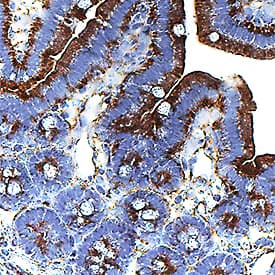Mouse Gas6 Antibody
R&D Systems, part of Bio-Techne | Catalog # AF986


Key Product Details
Species Reactivity
Validated:
Cited:
Applications
Validated:
Cited:
Label
Antibody Source
Product Specifications
Immunogen
Asp115-Pro673
Accession # CAA42507
Specificity
Clonality
Host
Isotype
Scientific Data Images for Mouse Gas6 Antibody
Gas6 in Mouse Intestine.
Gas6 was detected in perfusion fixed paraffin-embedded sections of mouse intestine using Goat Anti-Mouse Gas6 Antigen Affinity-purified Polyclonal Antibody (Catalog # AF986) at 1 µg/mL for 1 hour at room temperature followed by incubation with the Anti-Goat IgG VisUCyte™ HRP Polymer Antibody (Catalog # VC004). Before incubation with the primary antibody, tissue was subjected to heat-induced epitope retrieval using Antigen Retrieval Reagent-Basic (Catalog # CTS013). Tissue was stained using DAB (brown) and counterstained with hematoxylin (blue). Specific staining was localized to apical plasma membrane. View our protocol for IHC Staining with VisUCyte HRP Polymer Detection Reagents.Applications for Mouse Gas6 Antibody
Immunohistochemistry
Sample: Perfusion fixed paraffin-embedded sections of mouse intestine
Mouse Gas6 Sandwich Immunoassay
Reviewed Applications
Read 1 review rated 4 using AF986 in the following applications:
Formulation, Preparation, and Storage
Purification
Reconstitution
Formulation
Shipping
Stability & Storage
- 12 months from date of receipt, -20 to -70 °C as supplied.
- 1 month, 2 to 8 °C under sterile conditions after reconstitution.
- 6 months, -20 to -70 °C under sterile conditions after reconstitution.
Background: Gas6
Growth arrest-specific gene 6 (Gas6) was initially characterized as a gene whose expression was up-regulated in serum starved NIH 3T3 fibroblasts and whose expression is down-regulated during growth induction. Mouse Gas6 is a 673 amino acid protein that shares 81% identity to its human homolog. Gas6 is a member of the vitamin K-dependent family of proteins that includes human protein S, a negative coregulator in the blood coagulation pathway. Gas6 and protein S share structural motifs that characterize this family: an extensively gamma-carboxylated amino terminus (Gla domain), four EGF-like repeats, and a carboxy terminus containing globular (G) domains with homology to steroid hormone-binding globulin. It is a ligand for the Axl (Ufo/Ark), Sky (Dtk/Tyro3/Rse/Brt/Tif), and Mer (Eyk) families of tyrosine kinase receptors. Gas6 binds to these receptors via tandem G domains at its C-terminus. Gas6 is ubiquitously expressed, but most abundantly in lung, intestine, bone marrow and endothelium.
Gas6 has been implicated in a variety of biological processes. It serves as a mitogen for fibroblasts, endothelial cells, neural cells, vascular smooth muscle cells and several tumor-derived cell lines. In addition, Gas6 prevents apoptosis, independent of its mitogenic activity. Gas6 is capable of inducing cell adhesion and chemotaxis in specific cell types. It also supports vitamin K-independent hematopoiesis when expressed by stromal cells. Gas6 signal transduction following Axl/Sky/Mer receptor activation has been reported to occur through such diverse signaling pathways as PI3K, MAP kinase, Src, Ras and beta-catenin.
References
- Manfioletti, G. et al. (1993) Mol. Cell Biol. 13:4976.
- Goruppi, S. et al. (1996) Oncogene 12:471.
- Crosier, K and P. Crosier (1997) Pathology 29:131.
- Dormady, S. et al. (2000) Proc. Natl. Acad. Sci. USA 97:12260.
- Goruppi, S. et al. (2001) Mol. Cell Biol. 21:902.
Long Name
Alternate Names
Gene Symbol
UniProt
Additional Gas6 Products
Product Documents for Mouse Gas6 Antibody
Product Specific Notices for Mouse Gas6 Antibody
For research use only